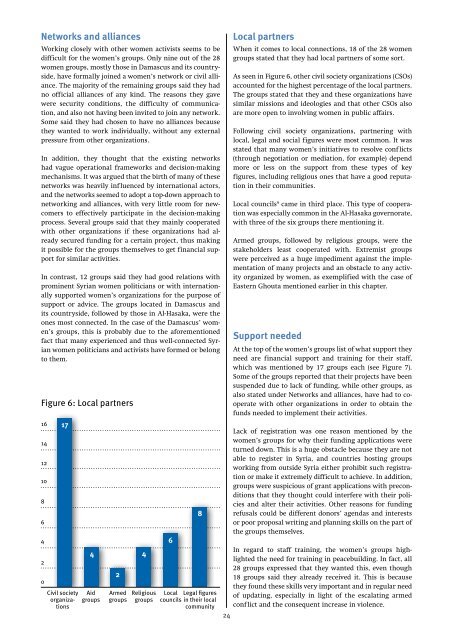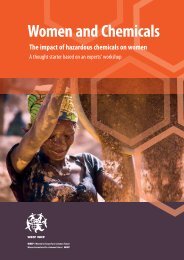future now”
YAO19
YAO19
You also want an ePaper? Increase the reach of your titles
YUMPU automatically turns print PDFs into web optimized ePapers that Google loves.
Networks and alliances<br />
Working closely with other women activists seems to be<br />
difficult for the women’s groups. Only nine out of the 28<br />
women groups, mostly those in Damascus and its countryside,<br />
have formally joined a women’s network or civil alliance.<br />
The majority of the remaining groups said they had<br />
no official alliances of any kind. The reasons they gave<br />
were security conditions, the difficulty of communication,<br />
and also not having been invited to join any network.<br />
Some said they had chosen to have no alliances because<br />
they wanted to work individually, without any external<br />
pressure from other organizations.<br />
In addition, they thought that the existing networks<br />
had vague operational frameworks and decision-making<br />
mechanisms. It was argued that the birth of many of these<br />
networks was heavily influenced by international actors,<br />
and the networks seemed to adopt a top-down approach to<br />
networking and alliances, with very little room for newcomers<br />
to effectively participate in the decision-making<br />
process. Several groups said that they mainly cooperated<br />
with other organizations if these organizations had already<br />
secured funding for a certain project, thus making<br />
it possible for the groups themselves to get financial support<br />
for similar activities.<br />
In contrast, 12 groups said they had good relations with<br />
prominent Syrian women politicians or with internationally<br />
supported women’s organizations for the purpose of<br />
support or advice. The groups located in Damascus and<br />
its countryside, followed by those in Al-Hasaka, were the<br />
ones most connected. In the case of the Damascus’ women’s<br />
groups, this is probably due to the aforementioned<br />
fact that many experienced and thus well-connected Syrian<br />
women politicians and activists have formed or belong<br />
to them.<br />
Figure 6: Local partners<br />
16<br />
14<br />
12<br />
10<br />
8<br />
6<br />
4<br />
2<br />
0<br />
17<br />
Civil society<br />
organizations<br />
4 4<br />
Aid<br />
groups<br />
2<br />
Armed<br />
groups<br />
Religious<br />
groups<br />
6<br />
8<br />
Local Legal figures<br />
councils in their local<br />
community<br />
24<br />
Local partners<br />
When it comes to local connections, 18 of the 28 women<br />
groups stated that they had local partners of some sort.<br />
As seen in Figure 6, other civil society organizations (CSOs)<br />
accounted for the highest percentage of the local partners.<br />
The groups stated that they and these organizations have<br />
similar missions and ideologies and that other CSOs also<br />
are more open to involving women in public affairs.<br />
Following civil society organizations, partnering with<br />
local, legal and social figures were most common. It was<br />
stated that many women’s initiatives to resolve conflicts<br />
(through negotiation or mediation, for example) depend<br />
more or less on the support from these types of key<br />
figures, including religious ones that have a good reputation<br />
in their communities.<br />
Local councils 9 came in third place. This type of cooperation<br />
was especially common in the Al-Hasaka governorate,<br />
with three of the six groups there mentioning it.<br />
Armed groups, followed by religious groups, were the<br />
stakeholders least cooperated with. Extremist groups<br />
were perceived as a huge impediment against the implementation<br />
of many projects and an obstacle to any activity<br />
organized by women, as exemplified with the case of<br />
Eastern Ghouta mentioned earlier in this chapter.<br />
Support needed<br />
At the top of the women’s groups list of what support they<br />
need are financial support and training for their staff,<br />
which was mentioned by 17 groups each (see Figure 7).<br />
Some of the groups reported that their projects have been<br />
suspended due to lack of funding, while other groups, as<br />
also stated under Networks and alliances, have had to cooperate<br />
with other organizations in order to obtain the<br />
funds needed to implement their activities.<br />
Lack of registration was one reason mentioned by the<br />
women’s groups for why their funding applications were<br />
turned down. This is a huge obstacle because they are not<br />
able to register in Syria, and countries hosting groups<br />
working from outside Syria either prohibit such registration<br />
or make it extremely difficult to achieve. In addition,<br />
groups were suspicious of grant applications with preconditions<br />
that they thought could interfere with their policies<br />
and alter their activities. Other reasons for funding<br />
refusals could be different donors’ agendas and interests<br />
or poor proposal writing and planning skills on the part of<br />
the groups themselves.<br />
In regard to staff training, the women’s groups highlighted<br />
the need for training in peacebuilding. In fact, all<br />
28 groups expressed that they wanted this, even though<br />
18 groups said they already received it. This is because<br />
they found these skills very important and in regular need<br />
of updating, especially in light of the escalating armed<br />
conflict and the consequent increase in violence.



